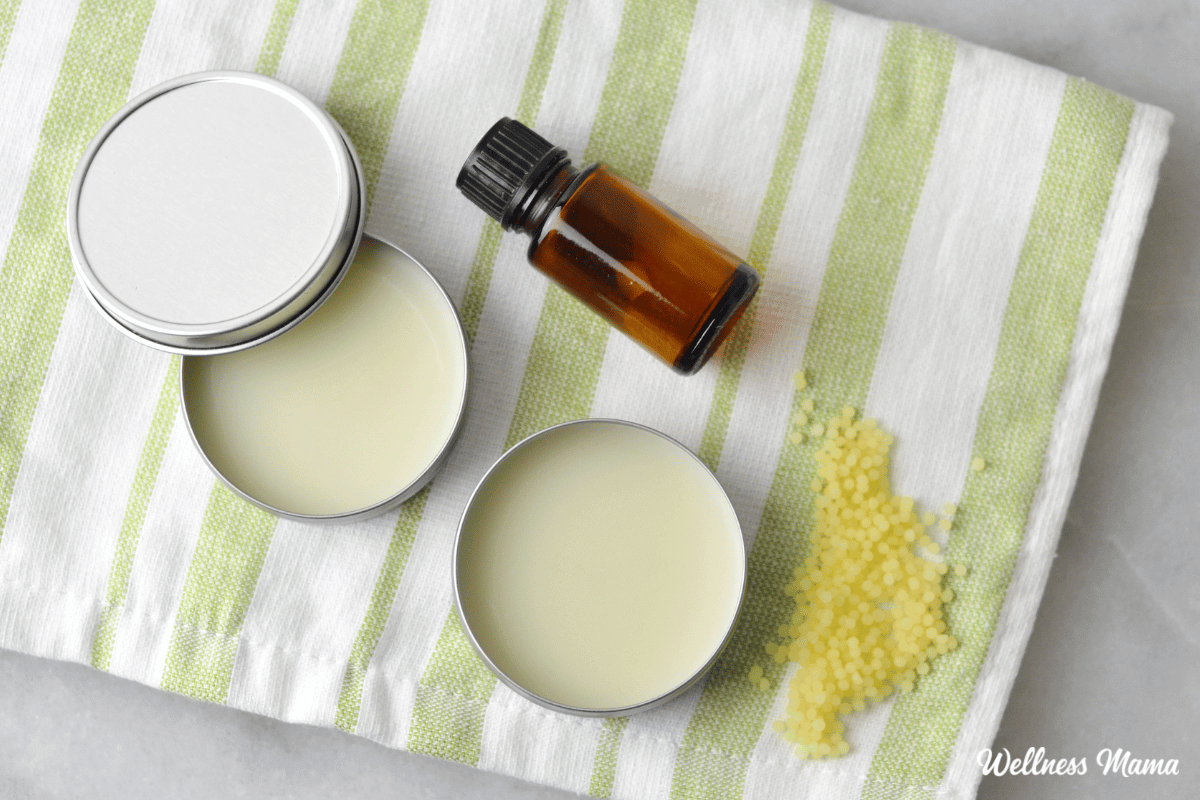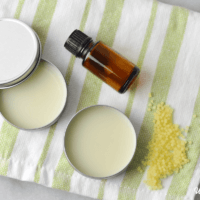Hopefully cold and flu season won’t strike your home this year. But in case it does, this natural vapor rub is a good home remedy to have around. It’s safe to use with adults and kids alike and is great for clearing up congestion!
I used to keep regular Vicks Vapor Rub and the baby version on hand for times when the seasonal cold would hit. That is until I realized it had PETROLEUM in it … yuck!
In the name of not consuming or slathering my children’s skin with anything that’s more beneficial to a car engine, I’ve been making this easy homemade vapor rub ever since. You can read more about the problems with petroleum jelly (Vaseline®) here.
How to Make a Natural Vapor Rub Alternative
The familiar blue bottle of vapor rub was a staple around my house growing up. Now as a parent, I understand why. Cold and cough treatment options are limited for babies and kids. And vapor rub is invaluable for soothing the coughing and congestion that can really interfere with everyone’s ability to get a good night’s sleep. The most essential component to getting well and staying well!
Don’t let the ingredient list deter you from making this recipe, either. If you don’t have the necessary ingredients on hand or don’t want to take the time to make this salve, mixing the essential oils with coconut oil works almost as well!
Store-bought Chest Rub
Thankfully, since I started making DIY natural products more companies have come out with natural versions. (Options are great!) I found a pre-made natural vapor rub in case you don’t have the ingredients on hand and there is even a formula specifically for babies and children.
I haven’t found it in a store near me yet, but if you have a Whole Foods or a natural health store nearby you might be in luck! Here are several good natural vapor rub options available on Amazon:
- Puriya Chest Rub Cream
- Babo Botanicals Eucalyptus Remedy
- Zarbee’s Soothing Chest Rub (includes a baby option)
- Badger Aromatic Chest Rub (for ages 2+)
- Maty’s Vapor Rub (for ages 2+)
- Maty’s Baby Chest Rub
Essential Oil Vapor Rub Safety
If you’re making this for babies or young children make sure to use essential oils that are safe for their age. I take the safe use of essential oils very seriously and err on the side of caution. I love this kid-safe line of essential oils because it takes a lot of the guesswork out of choosing the correct oils. The Sniffle Stopper is most like my blend in this recipe.
I sometimes make a gentler kid-safe version of this recipe by using just 4 drops of the eucalyptus and fir oils and omitting the rest. Here’s a list of all the essential oils used, what they’re for, and their safety precautions. (Also see the additional safety notes below the recipe).
Essential Oils for Vapor Rub
- Eucalyptus – The most popular chemotypes are E. Radiata and E. Globulus. Radiata is a little gentler, but it’s listed as near threatened so it’s important to buy from a reputable grower. Both are considered safe for diluted topical use on children ages 3 and up. Don’t apply eucalyptus to the face or sinus area of young children as it can cause breathing issues.
- Peppermint oil– Like eucalyptus, peppermint has 1,8 cineole in it that can cause breathing issues in young children if not used properly. It’s considered safe to use a .5% dilution (not on the face) for children ages 3 and up. Adults can use up to 5% topically, depending on the use. This recipe keeps it at less than 1% for older children and adults, and less than .5% for children 3-6. Peppermint is about 50% menthol, so it’s great for stuffy noses.
- Rosemary – This oil is a little harsher on little ones than some of the others. It’s high in camphor which makes it good for circulation and congestion. It’s a safe decongestant for ages 7 plus and the recommended maximum dilution is 4% for kids (up to 16% for adults). I omit this one when making a homemade vapor rub recipe for little ones.
- Cinnamon leaf – NOT cinnamon bark! Cinnamon leaf is gentler on the skin and is great for the immune system. It’s slightly warming and according to Tisserand and Young it’s safe for topical use with infants ages 3 months and up. Cinnamon bark has a high risk of skin irritation, can only be used topically in tiny amounts, and is not safe for children. Personally, I skip this one with young kids.
- Clove – Sometimes I’ll use clove instead of cinnamon leaf in this chest rub recipe. It can be used on ages 3 and older in certain situations, but it’s not the most gentle option. It’s not my preferred option for young children so omit for little ones.
Baby Vapor Rub Essential Oils
- Fir – Douglas fir or fir needle are gentle options that are great in a DIY vapor rub. They help the respiratory system and are generally safe for infants 3 months and older when diluted properly.
- Cedarwood (Virginian) – This woodsy-smelling oil makes a great ingredient in moisturizing men’s lotion. But it’s also perfect in home remedies for coughing and to help relax.
- Lavender – Like tea tree oil, lavender has skin-soothing properties. It’s also high in monoterpenes, making it great for respiratory support.
Natural Vapor Rub Recipe
Materials
- ½ cup coconut oil (or olive or almond oil)
- 2 TBSP beeswax pellets
- 20 drops eucalyptus essential oil (use 4-10 drops for children ages 3-6)
- 20 drops peppermint essential oil (use 10 drops for children ages 3-6)
- 10 drops rosemary essential oil (omit for children younger than 7)
- 10 drops cinnamon leaf essential oil (safe for ages 6 months and up, optional)
Baby Vapor Rub (6 months and up)
- ½ cup coconut oil (or olive or almond oil)
- 2 TBSP beeswax pellets
- 2-5 drops fir essential oil
- 2-5 drops cedarwood essential oil (cedarwood Virginian chemotype)
- 2-5 drops lavender essential oil
Instructions
- Melt beeswax with your carrier oil of choice in a double boiler just until melted. You can also use a heat safe glass bowl on top of a small pot.
- Turn off the heat and stir in the essential oils.
- Stir until well mixed and pour into a container with a lid to store. Small tins work well, as does a glass jar.
- Allow the vapor rub to cool completely and harden.
- Use as needed to reduce coughing and congestion. See safety information in article.
Notes
Safety Notes
Many essential oils, including some of these, aren’t considered safe for babies or small children. Make sure to always dilute essential oils for babies and children. I also use as little as needed. The natural vapor rub recipe is safe for ages 3 and up with the necessary modifications listed in the recipe. You can also put the vapor rub on the soles of their feet (ages 3-6) for a gentler option.
The baby-safe vapor rub version keeps the dilution at .5% and uses gentler oils. Experts generally consider these oils and at this dilution safe for babies 6 months and older. You can also cut the amount in half and use 2 drops of each essential oil if preferred.
Always check with a qualified healthcare provider about using herbs or essential oils on young children.
You can also make this recipe with herbs instead of essential oils by infusing the oil with 1 tablespoon of each of the herbs in a double boiler over medium heat for 2 hours.
This article was medically reviewed by Dr. Lauren Jefferis, board certified in Internal Medicine and Pediatrics. As always, this is not personal medical advice and we recommend that you talk with your doctor.
What are your tried and true remedies for beating congestion and cough? Ever made your own vapor rub? Share below!
- Tisserand, R., & Young, R. (2013). Essential Oil Safety (2nd ed.). Churchill Livingstone.
- Fensham, R., Laffineur, B. & Collingwood, T. (2019). Eucalyptus radiata. The IUCN Red List of Threatened Species 2019: e.T133374163A133374165.
- Parker, S. (2021). Carrier Oil Shelf Life. The Lipid Oils Academy.
- Robbins, W. (n.d.). Essential Oils Directory: Essential Oil Properties, Uses, and Benefits.
- Shutes, J. (n.d.). Aromatic Program Charts. The School for Aromatic Studies.



Leave a Reply